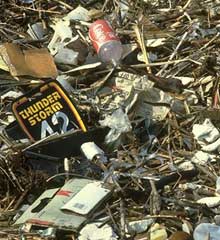What Is Marine Debris?
Types of Marine Debris | Sources of Marine Debris

Marine debris is typically defined as any man-made object discarded, disposed of, or abandoned that enters the coastal or marine environment. It may enter directly from a ship, or indirectly when washed out to sea via rivers, streams and storm drains.
Types of Marine Debris
Plastics
As society has developed new uses for plastics, the variety and quantity of plastic items found in the marine environment has increased dramatically. These products range from common domestic material (bags, cups, bottles, balloons) to industrial products (strapping bands, plastic sheeting, hard hats, resin pellets) to lost or discarded fishing gear (nets, buoys, traps, lines).

Glass, Metal, Styrofoam, and Rubber
These materials are similar to plastic in that they are used for a wide range of products. While they can be worn away – broken down into smaller and smaller fragments, they generally do not biodegrade entirely. As these materials are used commonly in our society, their occurrence as marine debris is overwhelming.
Derelict Fishing Gear
Derelict fishing gear (DFG) refers to nets, lines, crab/shrimp pots, and other recreational or commercial fishing equipment that has been lost, abandoned, or discarded in the marine environment. Modern gear is generally made of synthetic materials and metal, and lost gear can persist for a very long time.
Derelict Vessels
Thousands of abandoned and derelict vessels litter ports, waterways and estuaries, creating a threat to navigation, recreation, and the environment. Many vessels end up sinking at moorings, semi-submerged in the intertidal zone, or stranding on shorelines, on reefs or in marshes, and breaking apart. In protected harbors and bays these vessels may persist for years, while in open, exposed coastal environments the debris from disintegrating vessels may be widespread along shorelines and across underwater habitats.
Sources of Marine Debris
Ocean-based Sources
Materials can be dumped, swept, or blown off vessels and stationary platforms at sea. Among the ocean-based sources of marine debris are:
Fishing Vessels – Fishing gear may be lost from commercial fishing vessels as well as from recreational boats and from shore-fishing activities.
Stationary Platforms – Offshore oil and gas platforms are surrounded by water, and all items lost from these structures become marine debris. Marine debris generated from these platforms includes items like plastic drill pipe thread protectors, hard hats, gloves, and 55-gallon storage drums.
Cargo Ships and Other Vessels – Cargo lost overboard from freighters, cruise ships and other vessels poses serious threats to marine navigation. Container vessels caught in rough seas can lose the contents of their containers (sneakers, televisions, plastic toys, etc.), or perhaps even the entire container, a steel box 20 – 40 feet long, 8 feet wide and 8.5 feet high. Vessels carrying logs or lumber may lose large bundles or individual pieces of wood.
Land-based Sources
Debris generated on land can be blown, swept, or washed out to sea. Among the sources of the debris are littering, dumping in rivers and streams, and industrial losses such as spillage of plastic resin pellets during production, transportation, and processing.
Littering, Dumping, and Poor Waste Management Practices – Intentional or unintentional disposal of domestic or industrial wastes on land or in rivers or streams can contribute to the marine debris problem if a subsequent action carries the debris to the ocean.
Storm Water Discharges – Storm water that flows along streets or along the ground as a result of rain or snow can carry street litter into storm drains. Storm drains carry this water and debris to a nearby river, stream, canal, or even directly to the ocean. Marine debris from storm water runoff includes street litter (e.g., cigarette butts and filters), medical items (e.g., syringes), food packaging, beverage containers, and other material that might have washed down a storm drain.
Extreme Natural Events – Hurricanes, tornadoes, tsunamis, floods and mudslides have devastating effects on human life and property. The high winds, heavy rains, flooding, and tidal surges associated with extreme events are capable of carrying objects as light as a cigarette butt or as heavy as the roof of a two-story home far out to sea. During storms or other periods of strong winds or high waves, almost any kind of trash (including glass, metal, wood, and medical waste) can be deposited into the ocean.

